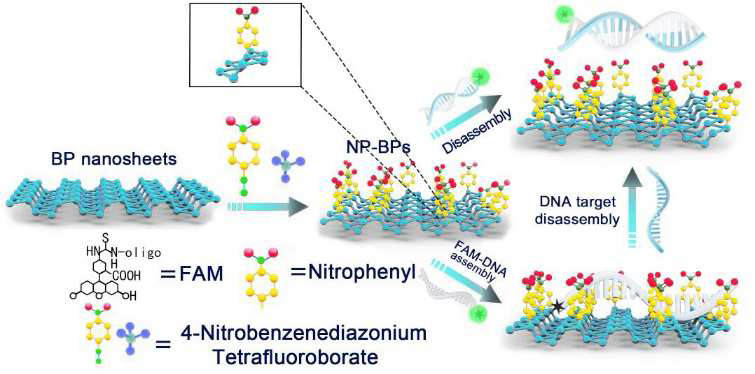Researchers Fabricate Novel Black Phosphorus Nanosheets for ctDNA Detection
Date:15-06-2020 | 【Print】 【close】
Circulating tumor DNA (ctDNA) is found in the bloodstream and refers to DNA that comes from cancerous cells and tumors, therefore ctDNA identification is one of the most meaningful approaches towards early cancer diagnosis.
However, there’re very limited effective and practical methods for analyzing this emerging class of biomarkers.
Researchers from the Shenzhen Institutes of Advanced Technology (SIAT), Chinese Academy of Sciences has fabricated a novel black phosphorus (BPs) nanosheets for sensitive and selective detection of ctDNA.
According to the study published in Biosensors and Bioelectronics, a nitrophenyl functionalized black phosphorus nanosheets (NP-BPs) biosensor was fabricated, which was based on the discrimination ability of the single-stranded DNA (ssDNA)/ double-stranded (dsDNA).
Due to the successful nitrophenyl functionalization, the NP-BPs biosensor synergistically increased the stability of BPs, enhanced hydrophobic and π-π stacking interactions between the biosensor and nucleotide bases, hence provided specific detection performances towards ctDNA.
This biosensor showed a great advantage in ctDNA detection with an excellent sensitivity of 50 fM and a wide linear detection range of 50 fM-80 pM. In addition to robustness and specificity in single nucleotide polymorphisms discrimination, this NP-BPs biosensor demonstrated the accurate detection of ctDNA in the clinic serum samples. More notably, the detection process was simple with good reproducibility and only took 15 minutes.
It is envisioned that the NP-BPs-based sensing platform has great potentials in early cancer diagnosis and monitoring cancer progression.

Schematic design of NP-BPs-based biosensor for ctDNA detection. (Image by SIAT)
Media Contact:
ZHANG Xiaomin
Email: xm.zhang@siat.ac.cn